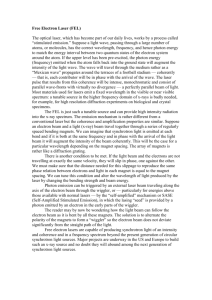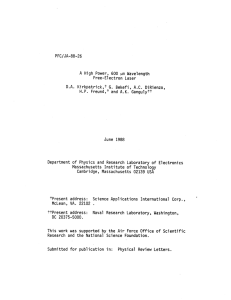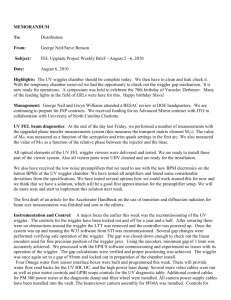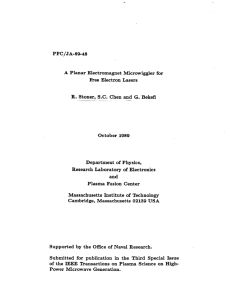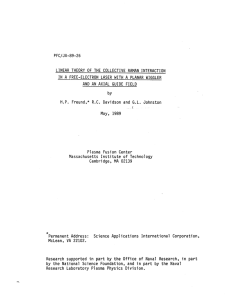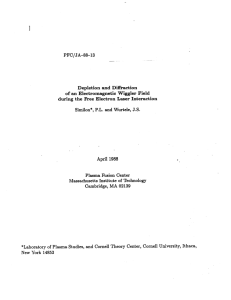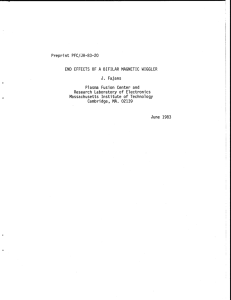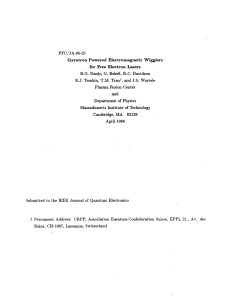Calvey_Thesis_Outline
advertisement
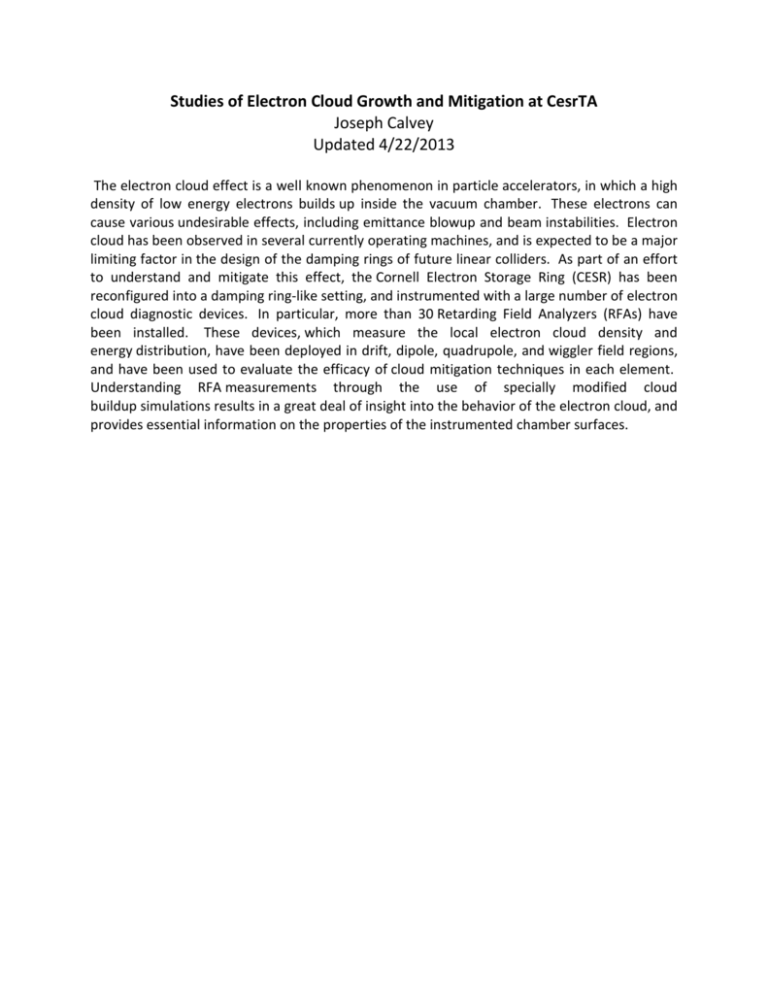
Studies of Electron Cloud Growth and Mitigation at CesrTA Joseph Calvey Updated 4/22/2013 The electron cloud effect is a well known phenomenon in particle accelerators, in which a high density of low energy electrons builds up inside the vacuum chamber. These electrons can cause various undesirable effects, including emittance blowup and beam instabilities. Electron cloud has been observed in several currently operating machines, and is expected to be a major limiting factor in the design of the damping rings of future linear colliders. As part of an effort to understand and mitigate this effect, the Cornell Electron Storage Ring (CESR) has been reconfigured into a damping ring-like setting, and instrumented with a large number of electron cloud diagnostic devices. In particular, more than 30 Retarding Field Analyzers (RFAs) have been installed. These devices, which measure the local electron cloud density and energy distribution, have been deployed in drift, dipole, quadrupole, and wiggler field regions, and have been used to evaluate the efficacy of cloud mitigation techniques in each element. Understanding RFA measurements through the use of specially modified cloud buildup simulations results in a great deal of insight into the behavior of the electron cloud, and provides essential information on the properties of the instrumented chamber surfaces. 1) Introduction / Overview a) Electron cloud i) Physics (1) Primary emission (2) Secondary emission (3) Space charge (4) Beam induced multipacting ii) History of EC (1) “Discovery” at KEK photon factory (2) Observations at PEP-II, KEKB, RHIC, PSR, SPS (3) Dedicated experiments at APS, PEP-II, KEKB, Main Injector, CESR (4) Concern for future machines: ILC damping ring, LHC upgrade iii) Problems caused by EC (1) Beam instabilities (e.g. head- tail) (2) Emittance growth (3) Beam loss iv) Cloud mitigation techniques (1) Beam pipe coatings (TiN, aC, NEG, DLC) (2) Grooves (3) Solenoids (4) Clearing electrodes v) EC simulations (1) Description of POSINST (2) Primary and secondary emission parameters (3) Other EC codes (ECLOUD, CLOUDLAND, WARP…) b) The CesrTA program i) CESR conversion (1) EC experimental regions (L0, Q14E/W, Q15E/W, L3) (2) CESR parameters, beam conditions available ii) Low emittance tuning iii) Studies of EC growth and mitigation (1) Retarding field analyzers (a) Basic description (b) Voltage vs current scans (c) Data acquisition system (2) Other methods (a) Shielded pickups (b) TE-Wave iv) Studies of EC induced instabilities (1) Tune shift, witness bunch studies (2) Head-tail studies 2) Drift RFA Studies a) Drift RFA styles i) APS ii) Thin, iii) Insertable I iv) Insertable II b) Measurements i) Example voltage scans (1) High vs low current ii) Bunch spacing study c) Mitigation comparisons i) Q14E Cu vs TiN ii) Q15E/W: Al, TiN, aC, DLC iii) Conditioning over time iv) Charging of DLC v) NEG activation/conditioning d) RFA Modeling i) Analytical model description (1) Secondary production in beam pipe holes (2) Realistic fields (non-ideal energy cutoff) ii) Bench measurements (1) Comparison with model e) Simulations and comparison with data i) Chi squared fitting method (1) Choosing parameters and data sets to fit (2) Sources of error ii) Results (1) Data/simulation comparison plots (2) Best fit parameters (3) Best fit SEY curves 3) Dipole RFA Studies a) Dipole RFA styles i) CESR dipole ii) SLAC chicane b) Measurements i) Voltage scan examples ii) Bifurcation of central peak iii) Cyclotron resonances c) Mitigation comparison i) Chicane: Al, TiN, TiN+grooves d) Bunch spacing studies i) Detailed multipacting model e) Dipole RFA modeling i) Strong dependence of efficiency on energy ii) Shortcomings of analytical model f) Simulations i) Qualitative agreement with data ii) Bifurcation iii) Cyclotron resonances? 4) Quadrupole RFA Studies a) Quad RFA description b) Measurements i) Majority of signal in collector 10 c) Mitigation comparison i) TiN effective d) Simulations i) Qualitative agreement with data ii) Long term trapping of cloud 5) Wiggler RFA studies a) Wiggler RFA description i) 3 RFAs/wiggler b) Measurements i) Center pole (1) Trampoline effect (2) Grooved wiggler ii) Longitudinal iii) Intermediate iv) L0 vs 19E c) Wiggler ramp i) Turn on of signal vs wiggler field ii) Disappearance of longitudinal signal d) Mitigation comparisons i) 2WA, 2WB wigglers ii) Clearing electrode scan e) Wiggler RFA modeling i) Integrated model f) Simulations i) Qualitative agreement with data (1) Reproduction of trampoline spike (2) Agreement at different bunch spacings ii) Simulation of wiggler ramp? 6) Conclusions a) Results/accomplishments i) Deeper understanding of the electron cloud ii) Detailed evaluation of different materials/mitigations iii) Validation of buildup codes iv) Input for future machines b) Future work i) Detailed comparison with other measurement techniques ii) Systematic fitting of dipole/quad/wiggler data iii) Further study of long term conditioning







